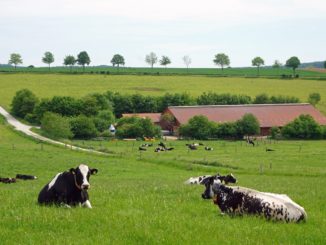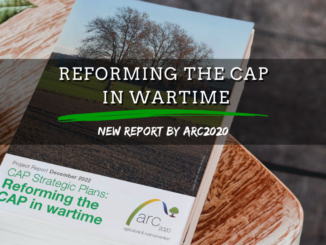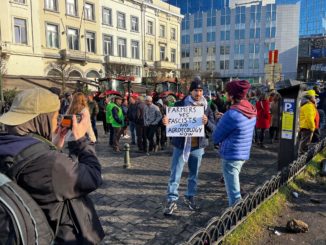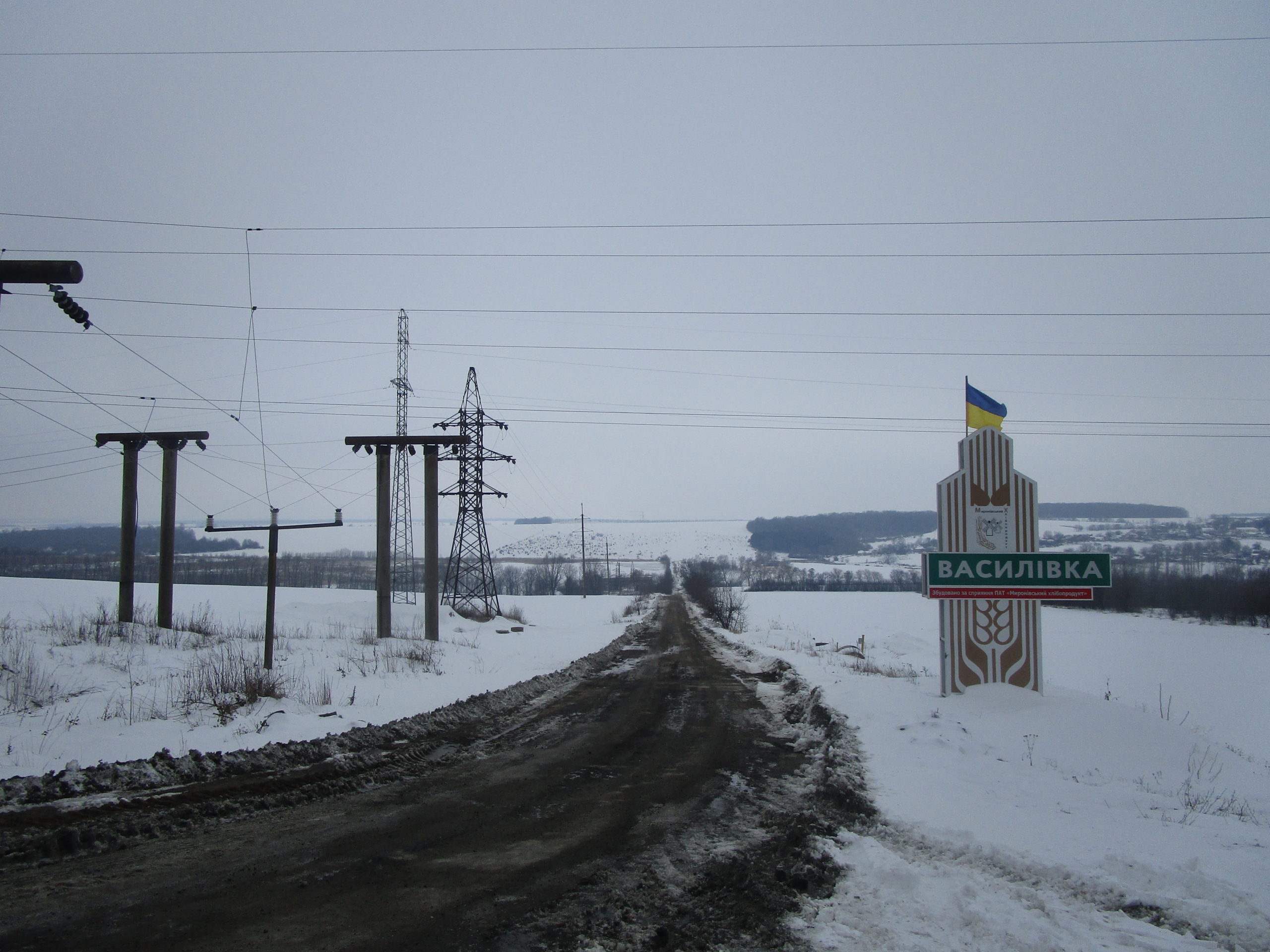
If Ukraine joins the European Union, and the current Common Agricultural Policy system of per hectare payments remains untransformed, oligarch-run conglomerates could become eligible for tens of millions of euros in taxpayer money. But this is not the only possible agricultural reality in an enlarged EU. There are farmers, researchers, civic initiatives and officials – like the delegates of Ukraine’s Vinnytsia region who visited Low Saxony in March 2023 – exploring ways to rebuild and reorient the country’s farming and food system in times of war. In this joint article, Hannes Lorenzen and Hans Wetzels posit that the EU and Ukrainian Regions will have to make a choice: prepare for an ecologically and socially resilient farming and food system with an integrated rural development concept, or hand the land over to agro-industrial giants. (updated 04/04/23 at 11.30 CET to add reference to support measure for Bulgarian, Polish and Romanian farmers announced March 20th)
By Hannes Lorenzen and Hans Wetzels
A delegation of the Region of Vinnytsia in Central Ukraine recently visited various agricultural and rural development projects and facilities in the Region of Lüneburg in Low Saxony, Germany, in order to gather ideas for recovery and reorientation of farming and food supply in times of war. The delegation comprised farmers, members of the public non-profit organisation Agrocluster AGROVIN, researchers, urban and rural planners and advisors, and the Deputy Head of the International Cooperation Department of the Regional Council of Vinnytsia region, Volodymyr Shevchuk.
“This tour was possible”, Shevchuk said, “because we received impressive support from the citizens’ initiative of Lüneburg. They have been supporting us since the war started. In past months we have received many trucks with medical, technical, clothes and food support. We were overwhelmed by the solidarity, and we decided to meet those people where they live to gather ideas on how we prepare for our future.”
From March 20 to 24 the delegation saw an agricultural research centre and farm school, a biogas plant, processing facilities for herbs and fruit, a cooperative of organic potato farmers and a wind energy cooperative. They talked with students, gardeners, farmers and entrepreneurs, and they discussed perspectives of Ukraine joining the EU in a currently rather unpredictable future.
Indeed, the perspective of Ukraine joining the EU is not just a one-way road to rapid integration, especially when it comes to the future of the Common Agriculture Policy (CAP). It is the elephant in the room of EU decision-makers which nobody currently seems to take note of. In fact, with the current CAP system of per hectare payments to farmers still in place and an open common internal agricultural market, the CAP budget would just evaporate once Ukraine becomes an EU member state.
In times of war, the EU Commission and heads of states have raised expectations that Ukraine should join the EU soon – which the Union has promised to West Balkan countries for decades.
From the point of view of European farming and rural development, it is worth taking a closer look at what Ukraine’s accession would mean for the EU and what it would mean for Ukrainian farmers – and the future of the CAP itself. Because with an accession of Ukraine, oligarch-run conglomerates could immediately become eligible for tens of millions of euros in EU-taxpayer money.

| Vinnytsia Region comprises 26,513 km2 with over 2.014 million hectares of agricultural land, including 1.725 million hectares of arable land, 48,000 hectares of perennial plantings, 19,000 hectares of hayfields, and 107,400 hectares of pastures. The vast majority is high quality black soil (near 1.667 million hectares). The region contributes 8.3 % to the gross agricultural output of Ukraine (76% in the agricultural enterprises, 24% in the smallholder households). The region has: 844 collective enterprises, 1836 private middle size and small farms and 273,500 single owners. 99.2% of rapeseed, 87.4% of soybeans, 95% of sunflowers, 91% of sugar beets and 86% of cereals are produced in agricultural enterprises. The structure of livestock production: agricultural enterprises produce 92.3% of all types of meat. In smallholders households: 74% of milk and 57% of eggs.
Source: Podillia Institute for Agriculture of the National Academy of Agrarian Sciences of Ukraine, March 2023 |
Ukraine – A global agricultural powerhouse
Ukraine is a global agricultural powerhouse in its own right. In the second half of the 19th century the harbour town of Odessa became the most important exporting centre of the Russian Empire – redirecting the rivers of grain flowing out of the Ukrainian heartland toward the then rapidly expanding industrial cities of Europe. Its pre-war annual agricultural exports totalled about 27.8 billion dollars – 41% of the country’s total exports.
The highly fertile, humus-rich black earth of Ukraine is legendary for its productivity, enabling smart trading houses to amass fortunes. Up to this day, Ukraine is a major global supplier of grains, sunflower, oilseeds, and has growing meat, dairy and soya producing industries. In total the country has about 30 million hectares of highly productive soils: the biggest agricultural acreage in the European zone.
Ukraine is the third biggest exporter of grain and the fifth for wheat worldwide. Vinnytsia is the agricultural heartland of Ukraine and contributes 8.3% to the gross agricultural output of the country. The regional agriculture sector is dominated by one giant company: poultry producer Myronivsky Hliboproduct (MHP).
MHP – A chicken giant
Since Ukraine gained independence in 1991 after the collapse of the Soviet Union, oligarchs scrambled for the land and were able to amass their fortunes, leading to rapid land concentration, growing inequality and environmental degradation in rural areas.
Environmental, social and good governance metrics have been under pressure since Ukraine morphed into a wild-west capitalist economy. Land concentration often borders semi-legality, while examples of groundwater pollution, bribery of local officials, illegal logging or unsafe manure storage are legion.
Legally prohibited genetically modified crops are exported from Odessa port in large quantities and a governmental moratorium on farm inspections makes it hard to monitor conditions of animal breeding.
MHP carries the same story. The company entered the Ukrainian market in 1998 only to become the largest chicken meat producer in the entire Southeast of Europe. MHP is owned by Yuri Kosyuk, an oligarch owning assets estimated at about 1.1 billion dollars. His giant operation has fully integrated its supply chain into an efficient machine spanning the whole of Vinnytsia, yet it is registered and paying taxes in Cyprus. MHP leases about 360,000 hectares of agricultural land from landholders, produces its own feed maize and sunflowers, slaughters its own chickens, owns a fleet of trucks and has a supermarket chain of its own.
Since 2018 inhabitants have been fighting MHP’s expansion. The presence of the company is visible everywhere. Standing on a hilltop overlooking the soft white flow of the landscape, all of the land visible until the horizon is operated by MHP only. The roads have been built by MHP, a security service hired by MHP patrols the area. A nauseating stench from the enormous chicken crematorium down the road fills the air. The whole region has slowly turned into a giant chicken production line.
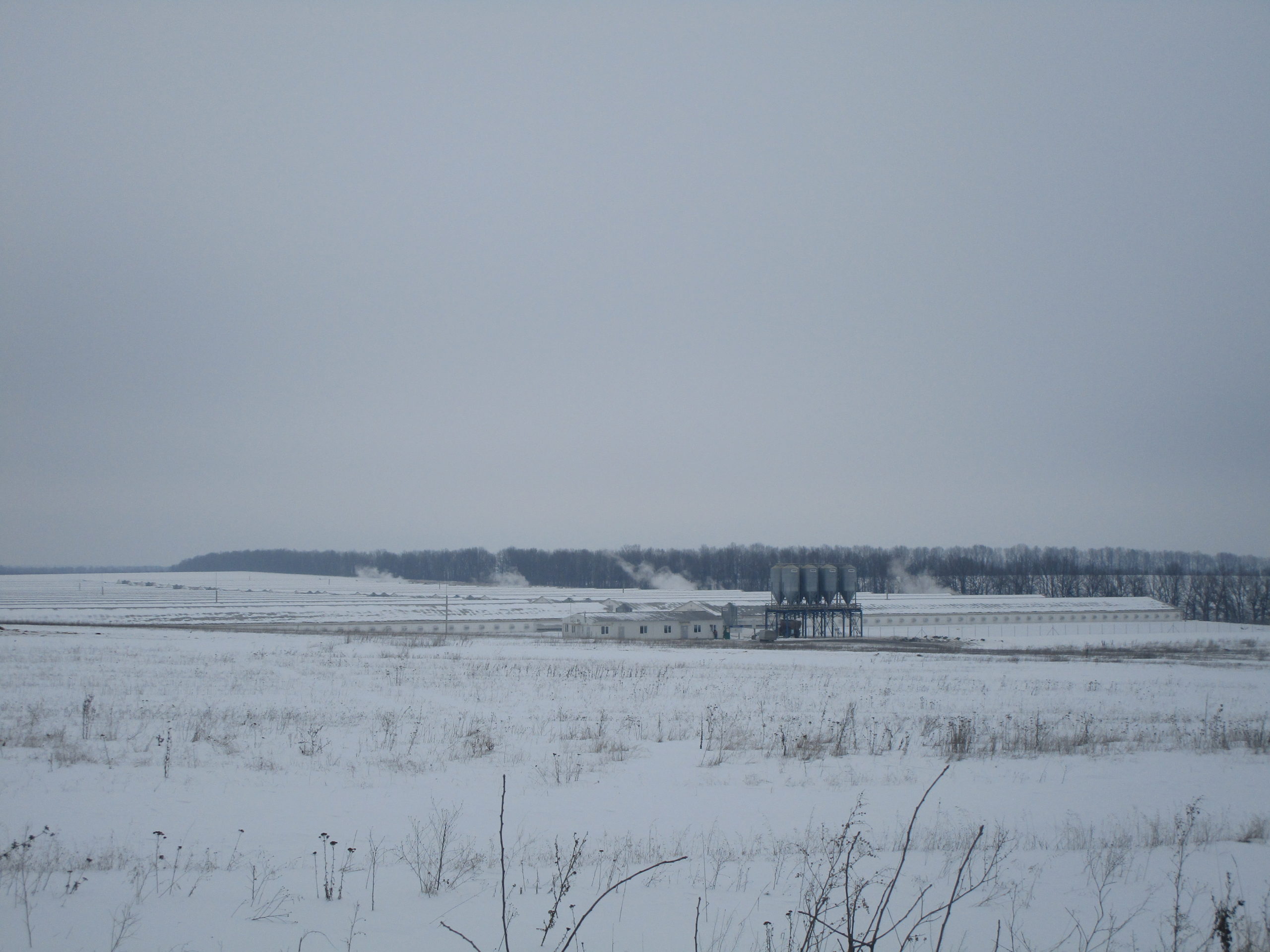
Many farmers lease their land to MHP and receive hefty sums of money in return, so regional support for the agricultural giant remains high. Other farmers fear dropping groundwater levels since MHP started production and have with the help of environmental experts ascertained a quick increase in nitrate and ammonia pollution.
But proof remains hard to come by since MHP does not permit water measurements on lands leased by them. ‘When we protested against their expansion plans by blocking the road for three days, local politicians didn’t even bother to show up,’ one elderly woman named Ljudmila Vdovichenko testified.
A European Bank financing a monopoly
The core of MHP’s business are the tens of giant hen houses and broiler production units spread over the hills of Vinnytsia. In long, white buildings, MHP can keep up to 1.5 million chickens per facility. They are surrounded by high fences and patrolled by guards in army garments.
1,300 inhabitants of the village where Vdovichenko lives had by February 2018 been completely surrounded by chicken production facilities. Trucks speed by over the narrow village streets 24 hours a day. Research commissioned by the local city in 2016 showed that 46 houses have suffered serious damage along the MHP-supply routes.
The expansion of MHP is mostly financed by international institutions; the European Bank for Reconstruction and Development (EBRD), the International Finance Corporation of the World Bank, the European Investment Bank and private banks such as Rabobank have all lent substantial amounts of money to MHP.
In 2018, farmers from three municipalities in the region filed a complaint about MHP with the EBRD. The Ukrainian villagers were supported by the American legal NGO Accountability Counsel: an organisation that specialises in conflicts between big companies and local communities. ‘The biggest problem we keep running into is that we don’t have access to any information, said lawyer Caitlin Daniel. ‘For us it’s almost impossible to find out whether MHP lives up to European norms and regulations at all.’
An agroindustrial model for the EU – what will be left of European farming?
Yet – when Ukraine joins the EU, companies like MHP would automatically become eligible for large amounts of money from an unchanged Common Agricultural Policy (CAP).
News website Politico reported that if Ukraine were to become a member of the EU tomorrow, it would get by far the biggest chunk of money from the CAP since its farmlands cover an area larger than all of Italy.
According to the Ukrainian Grain Association, only 10 giant companies dominate its agricultural market by 71%. Based on land bank size, MHP is the third largest, only topped by the (for tax purposes) Luxembourg based conglomerate Kernel operating 558,000 hectares in early 2020, and Ukrlandfarming with 470,000 hectares of land spread out through entire Ukraine to grow wheat, corn, barley, and rapeseed. Furthermore, Ukrlandfarming is involved in egg production, sugar beets processing, cattle breeding, meat and milk production, and seeds trade.
Despite the moratorium on land sales that will be fully lifted by 2024, foreign agricultural players have been flocking into Ukraine for years. For the German-American seed conglomerate Bayer-Monsanto, Ukraine represents more than 20% of total European market share, while the world’s biggest grain trader, Cargill from Minnesota USA, started loading ships from a joint venture cargo facility on the Black Sea in 2021.
Farmers organisations inside the EU are forewarning the impact of Ukrainian EU-accession. Import tariffs on Ukrainian goods have been temporarily lifted as a means to support the Ukrainian agricultural sector. During the AGRIFISH council on January 30, 2023, the Polish delegation, together with the Bulgarian, Czech, Hungarian, Romanian and Slovak ministers presented a position to limit surging imports of Ukrainian grain and called for compensation of affected farmers in their respective countries: ‘Considering the above, we believe that the European Commission should propose instruments to prevent the increasing difficulties of EU producers caused to a large extent by a very serious increase in imports of Ukrainian agricultural products to the EU market.’
On March 20th, the Commission announced a support measure worth 56.3 million euros for Bulgarian, Polish and Romanian farmers, due to the volume of crops and oilseeds entering the EU already. This “is expected to compensate affected farmers for the economic loss due to increased imports of cereals and oilseeds and limit the impact of market imbalances on their planting decisions”
In the western parts of the continent, chicken imports from Ukraine have soared since the lifting of EU custom duties on Ukrainian goods. One company stood out to benefit: MHP. ‘Ukrainian chicken imports into the EU jumped 54% year-on-year in the second quarter to about 52,000 tonnes,’ Reuters news agency reported on the matter. ‘French poultry industry group Anvol said on Wednesday, forecasting the total volume for 2022 at between 130,000 and 180,000 tonnes.’
Full trade liberalisation – No Green Deal
According to European Commission sources, Ukraine has requested an extension of full trade liberalisation until 2024, but no decision has been made on that yet.
The impact on CAP-funding of Ukrainian accession to the EU could be become an even bigger issue.
With an unchanged CAP, it would lead to a massive transfer of money from western EU-member states to the biggest Ukrainian conglomerates spanning hundreds of thousands of hectares and flooding EU-markets with cheap produce.
Calculated by the official EU-average from 2015 of 266 euros yearly per hectare, Ukrainian market leader Kernel would become eligible for no less than 148 million euros a year in direct income support after Ukrainian EU-accession. Direct competitor Ukrlandfarming could receive up to 125 million while MHP would hark in a still hefty 97.8 million euros each year.
According to the European Commission, the accession procedure of new member states covers a large number of binding rules – many of which are directly applicable. The proper application of these rules and their effective enforcement by a public administration are essential for the functioning of the Common Agricultural Policy (CAP).
Running the CAP requires the setting up of management and quality systems such as a paying agency and the integrated administration and control systems and the capacity to implement rural development measures. Member States must be able to apply the EU legislation on direct farm support schemes and to implement the common market organisations for various agricultural products. The accession of Ukraine into the EU would influence all EU policies by definition – including the CAP. Still, the Commission sticks by the notion that it remains impossible to assess the impact on the CAP prior to the outcome of possible negotiations and that accession is not about reforming EU policies such as the CAP.
Another Ukraine is possible
What all that means for Vinnytsia is still in the air. Changes are already underway in the region, the farmers gathered in Lüneberg told ARC2020. Since the EU-Ukraine Association Agreement came into effect territorial reforms have been initiated to decentralise administrative processes. New regional political entities have received new tax and budget rights and have stronger independence concerning food and farming policies and rural infrastructure.
Member of the delegation to Low Saxony Serhiy Hutsol, CEO of the public non-profit association Agrocluster AGROVIN, explains the new territorial rural development approach, which his organisation is pursuing together with the city of Vinnytsia:
“We wish to animate cooperative structures of production and marketing. We want to reduce dependence on imports from other regions of Ukraine, having suffered from a major supply stop of food from the Cherson and Mykolaiv region which was heavily struck by the war, and we want a more sustainable production like organic farming. We see growing problems stemming from climate change, loss of topsoil and water resources.”

Oleksanadar Zakorchennyi, advisor of the mayor of the City of Vinnytsia, responsible for urban-rural planning and administration and part of the delegation to Lüchow, is responsible for a new green belt strategy of the city.
“We try to mobilise our urban and rural inhabitants to work closer together to establish a food strategy for the city just like Amsterdam and Copenhagen do”, he explains. “It needs communication and inclusion of the population and a better distribution of the land around the city.” The total surface cultivated as part of the planned green belt plan is 10,000 ha – of which 7000 ha are cultivated by 26 farming enterprises. The remaining 3000 ha are owned by 80% of the population in the suburbs with an average of 1 to 3 hectares per owner.
“Our intention, especially in times of war, is to encourage food production and food security near the city. We want fresh vegetables for the urban population and the establishment of food councils and cooperatives. Small gardeners and farmers around the city mainly use the land for subsistence production. But we also need food for a local market. We will establish small food processing facilities near the city as we need continuous supply, better organisation and cooperation of the gardeners and small farmers. We have 60 beekeepers and many vegetable producers who are interested in participating”.
The EU and Ukrainian Regions will have to make a choice, whether to prepare for an ecologically and socially resilient farming and food system, including an integrated rural development concept, or whether to hand the land over to agro-industrial giants like MHP, Cargill and Ukrlandfarming. The EU Green Deal, the Biodiversity Strategy, Farm to Fork, or the recent proposal for a Sustainable Food System law do not match with an extractive, unhealthy and polluting system of that kind. The EU and Ukraine should get prepared for a demanding future now. Further sleepwalking with a CAP of the past is not an option.
Restructuring the CAP for EU-EnlargementIn March 2023, a top German government official stated that the EU must prepare the CAP for the next funding period from 2028 onwards to be able to accommodate Ukraine. ‘Of course, the question is whether the accession of the candidate countries will really take place in the next funding period,’ Silvia Bender, State Secretary of the German Farm Minister Cem Özdemir has been quoted saying at an event on March 21, 2023 – pointing to some countries needing ‘faster accession prospects in order to be stabilised domestically.’ From the viewpoint of the German Ministry, EU-enlargement could have significant ramifications for how the CAP is structured in the future – since funding direct payments to so many and such large additional Ukrainian farms could pose major challenges to the EU-budget. ‘If Ukraine were to join, then a system of direct payments as we have it today would definitely no longer work,’ a spokesperson of the Federal Ministry of Food and Agriculture in Berlin confirms the views of the State Secretary. However, the same ministry has been unambitious in limiting industrial farming practices and boosting agro-environmental practices in the German national strategic plan, which would qualify CAP support and rules for future farming within the EU and for accession countries. Accession of Ukraine would accelerate the downward spiral of environmental and climate disaster if the EU did not set stricter standards than what the current CAP reform has established. The direction the CAP might take in the next few years could have a transformative effect in neighbouring countries like Ukraine as well. In 2019, FAO-director director for Eastern Europe (including Ukraine, Albania, Georgia, Moldova and Armenia) Raimund Jehle told ARC2020: ‘In agriculture, Ukraine is the fourth EU-trading partner after the UK, Brazil and the US. Downside is that the land concentration in rural areas is enormous; farms of over 30,000 hectares are not unusual, and that leads to problems both on the social and the environmental level. Besides those commodities, the biggest export growth in fact lies in sectors dominated by smallholders, like fruits. Since the Association Agreement came into effect, fruit exports to the EU have doubled, and the export of vegetables has grown from 11 million euros in 2015 to 86 million in 2018. Compared to bulk commodities, those numbers are still relatively small, fruits and vegetables account for about 3% of agricultural exports from Ukraine. But the opportunities for bigger growth are there.’ |
More on Ukraine
Ukraine | the Green Road of Ecovillages – Communities that Protect


